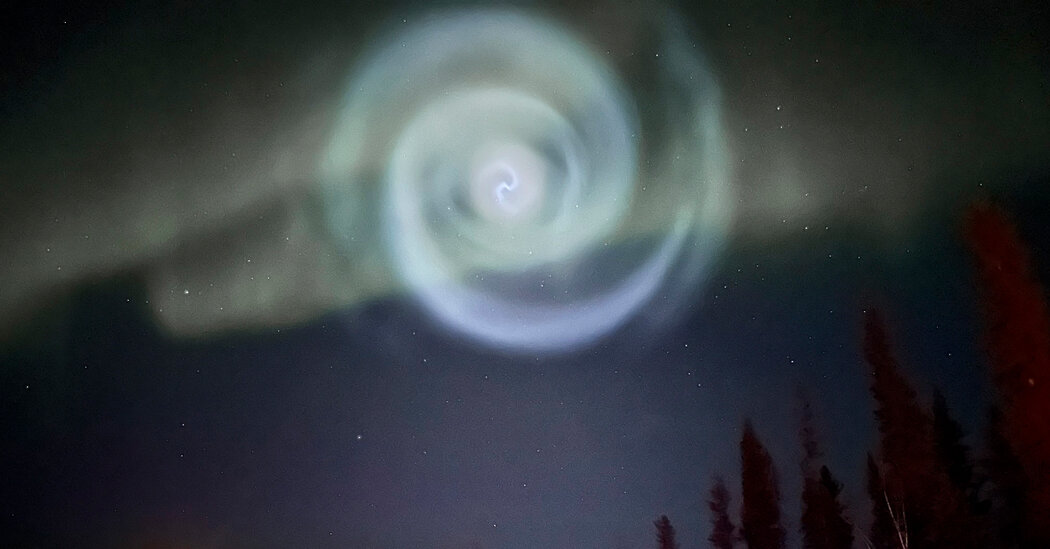At first, Ronnie Cole thought the bright light in the sky over southern Alaska was an airplane.
Mr. Cole, a tour guide with Alaska Photo Treks, was setting up a portrait with two of his clients in the early hours of Saturday when he noticed “there was something weird about the light.”
“It started to create a spiral pattern, it was really small at first,” he said. “Then, it moved out of the clouds and the spiral was still there, and it was just getting bigger in the sky. That’s when I realized that it was something else.”
The blue spiral made its away across the sky’s green and red hue of the northern lights for about three minutes before disappearing over the tree line near Trapper Creek, about 100 miles northwest of Anchorage.
“I’ve spend about 1,000-plus hours out watching the night sky every winter,” Mr. Cole said. “I see a lot of weird things in the sky, but that was definitely the most unusual.”
It wasn’t until 8 a.m., when he got home from the tour, that Mr. Cole learned on social media what it was. As foreign as the swirl seemed, the answer was simple: SpaceX had launched a Falcon 9 rocket in California, and the reflection of the excess fuel it released into the atmosphere had probably created the dizzying pattern.
Needless to say, at the time of the phenomenon, the rest of Mr. Cole’s tour clients spilled out of a nearby van to get a better look.
“It was really a surreal experience to see this constantly expanding spiral coming across the sky coming toward us,” he said. “I didn’t even bother moving my camera, I was just hitting the shutter button.”
Mr. Cole was one of a number of spectators, both in person and afar, to observe the spectacle of a SpaceX rocket careening against the natural spectacle of the northern lights. The rocket launched from Vandenberg Space Force Base in California on Friday night, carrying 51 pieces of cargo, and three hours later could be seen over Alaska. A similar spiral was seen over Hawaii in January.
Don Hampton, a research associate professor at the Geophysical Institute of the University of Alaska Fairbanks, called the sighting “unique,” in part because of the specific conditions allowing it to occur: It was a clear, dark night on the ground, and the rocket fuel or exhaust was released into the direct sunlight of the aurora, spiraling in “a long, sprinkler effect.”
“If this had happened in the middle of winter, you probably wouldn’t have seen it because the sun’s shadow would have been much higher,” he said.
Mr. Hampton said the rocket was probably dumping fuel high enough in the atmosphere that ultraviolet light broke it down and dispersed the particles across the globe. He said that pollution from the rocket fuel was not a great concern.
Aurora borealis, the natural displays of color commonly referred to as northern lights because of their visibility at higher latitudes, occur when charged particles from the sun collide with charged particles already in Earth’s magnetic field, releasing energy into the atmosphere that interacts with gas to create the visible glow.
The lights attract tourists like Mr. Cole’s group and Kristen Lange, who first visited Alaska last year with her husband and now owns a house just north of Fairbanks. However, she doesn’t have to leave her home in Midlothian, Texas, to see an aurora. In fact, this time of year, Ms. Lange starts her mornings in Texas by watching the previous night’s sky via cameras angled toward the sky that sit atop her Alaska home.
The cameras have captured a couple of shooting stars, meteorites and satellites, but as Ms. Lange was reviewing the tape on Saturday morning she saw a bright ball.
“I was like, ‘What the heck is that?’” she said on Wednesday. She sped up the time lapse video as a blue swirl traversed a green sky and consulted a sky map. “This time we caught Falcon 9.”
She said it was “the coolest thing we could possibly catch.”
And it probably won’t be the last time it happens, Mr. Hampton said.
“It's just a fun spectacle to see, and as we continue to do more launches, especially some of the larger ones, people will likely see them again,” Mr. Hampton said. “It’s reasonably well explained. It’s not the aliens landing as far as I know. They may be landing, but that was not an indication they were.”
Source: Read Full Article
